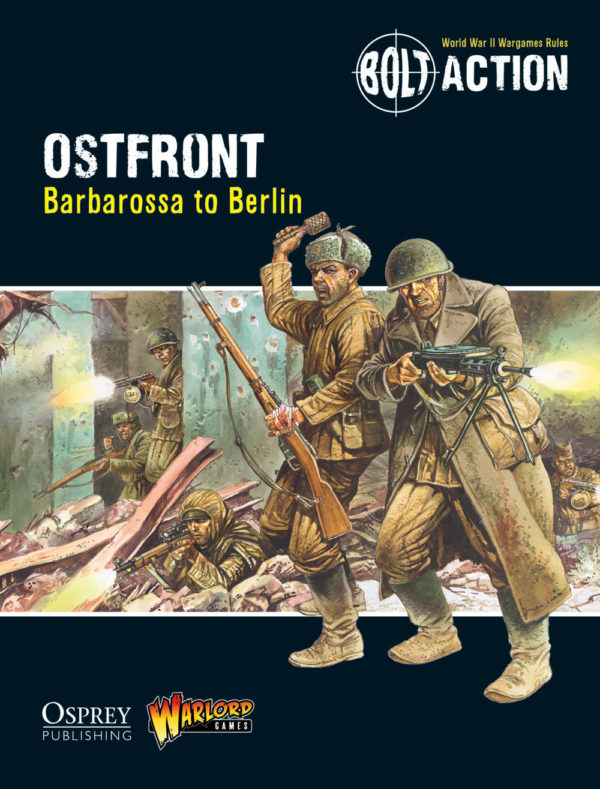At 6pm on August 23rd 1942 the assault on the Soviet city of Stalingrad began by Army Group 6 under the Command of Colonel General Friedrich Paulus.
However that had not been the start of the destruction; this began with air strikes from German Luftflotte 4. Between the 25th and 31st of July around 1,000 tons of bombs were used upon the city, damaging about 80% of the city structures. Huge oil tanks exploded, spewing oil into the Volga – which in turn set alight – the river was ablaze, 32 soviet ships were sunk and another 9 seriously damaged by the Wehrmacht’s aerial bombardment.
Stalin quickly recognized the threat to the city of Stalingrad, and on 1 Aug 1942 appointed Colonel General Andrey Yeryomenko as the commanding officer of the South Eastern Front to build defences and organise the defence of the city. Along with him was Political Officer commissar Nikita Khrushchev, sent to assist Yeryomenko. Yeryomenko in turn appointed Lt. General Vasily Ivanovich Chuikov as commander of the 62nd Army, declaring that the City must be held at all costs!
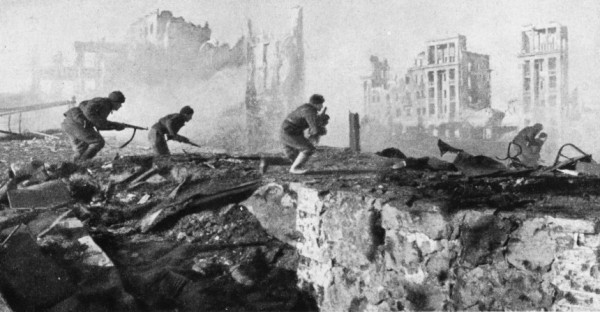 On the 23rd August a massive air raid took place, causing a firestorm throughout the city – killing thousands. However, Yeryomenko was one step ahead, and had moved all the grain, cattle, railroad cars, and factories across to the Eastern side of the Volga, to avoid any disruption of production and supply.
On the 23rd August a massive air raid took place, causing a firestorm throughout the city – killing thousands. However, Yeryomenko was one step ahead, and had moved all the grain, cattle, railroad cars, and factories across to the Eastern side of the Volga, to avoid any disruption of production and supply.
Stalingrad had become a gigantic pile of rubble stretching along the side of the Volga River. By August 31st there were only 192 soviet aircraft operable, of which only 57 were fighters. Even though there were constant bombardments from German aircraft, the remaining factories which hadn’t been able to move due to lack of time continued their work turning out tanks and war supplies – and did so until they were too badly damaged.
The city of Stalingrad became known as a rat run to the soldiers involved in the fighting. No soldier on either side could move in the open on foot. All movement now took the form of crawling or a hurried run. German soldiers were very careful around sewer entrances – as they were often snatched by their Russian adversaries and taken for interrogation by the NKVD. Soldiers were constantly fighting in brutal hand to hand combat – every city street was fought for metre by metre, and every building was fought room by room.
The favoured weapon of many of the Russian soldiers for close quarters fighting was not his sub-machine gun, knife or bayonet – but his entrenching tool – many Russian soldiers had one side of the entrenching tool sharpened. The use of rifles was quite minimal in such close confines, leading the Russians to use special assault squads armed entirely with sub-machine guns and grenades, with covering fire from the medium machine guns.
The Russian soldiers were much better fighters in hand to hand and trench warfare than the Germans had anticipated. Every building quickly became a strong point, and even the sewers had become battlegrounds – every inch of the city was under contention.
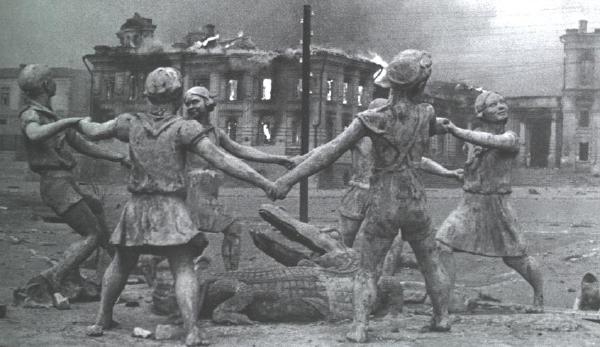
The iconic Barmaley Fountain, made famous by the photographs of Ammanuil Evzerikhin in August 1942. The juxtaposition of the children happily playing against the ruinous backdrop made the fountain something of an icon of the battle.
Another key aspect of the battle was that soldiers on either side were under constant threat from sniper fire. This became known in the Russian lines as Sniperism, and became a very big part of the propaganda war.
The railroad station became the scene of ferocious fighting. On one day alone the railway station marshalling yards exchanged hands from Russian to German and back 14 times in a 6 hour period. The Germans finally captured it but only because they had completely wiped out the Russians deployed there. General Chuikov had said the only way a building could be taken from the Russian defenders was if they had all been killed.
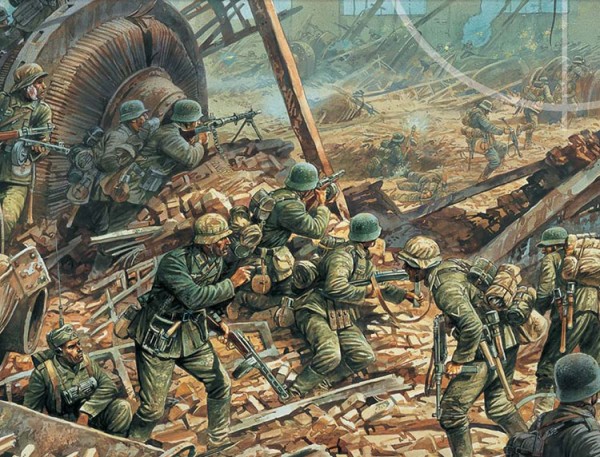
The tractor factory had 900 dive bomb attacks laid upon it on 5th October – this wiped out entire regiments of troops that were entrenched there. 2,000 sorties were flown against many Soviet positions on 14th October; these dropped 600 tons of bombs.
By this point in the battle the defenders had been pushed back to the point where the Volga River was at their backs. The defenders were squeezed into a pocket 910m wide. It was not uncommon for Soviet and German positions to be as close as 10 or 20m apart; there were constant skirmishes between attacker and defender. A building could change hands two or three times in a single skirmish, with Germans holding one room, and Soviets the next… there were even occasions on which the Germans might hold the ground floor of a building, the Soviets might hold the next floor, and then the Germans would hold the floor above that!
The Germans began to place improvised metal netting over their dug-outs and trenches so that Russian grenades would simply roll off on landing… the Russian soldiers in turn improvised hooks and attached them to the grenades, so that they’d catch onto the mesh.
In the first 10 days of November the pressure of German attacks was kept at a high level, only small attacks were made each time – but they were many. The crossing point of the Volga was now under constant fire. Winter had set in, and Chuikov was dreading what he called ‘the war on 2 fronts’, the war against the German attackers and the war against the Volga to their rear.
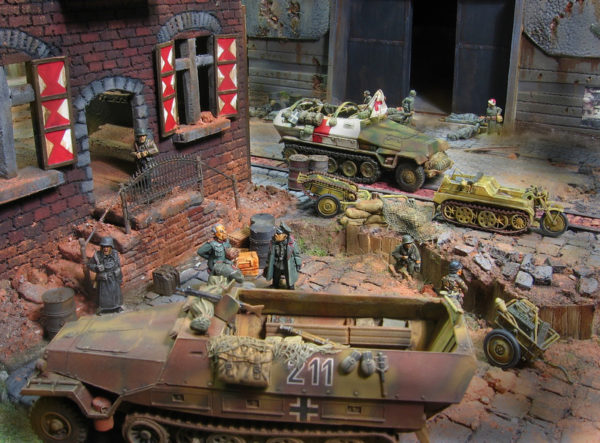
A company from the 347th Rifle Regiment dug in 200 yards west of the Volga bank were down to just nine men when they were overrun on November 9th – the commander Lieutenant Andreev rallied the troops and carried out an immediate counter attack, armed only with sub machine guns. A group of reinforcements that had just arrived in the nick of time cut off the Germans and saved the Northern crossing point for the Russian 62nd army. The Russian troops watched the Germans signalling to their artillery and used this to their own advantage – in one instance a Russian platoon commander switched his flares to those of captured German colours at exactly the right point so that the artillery fired upon the German forces.
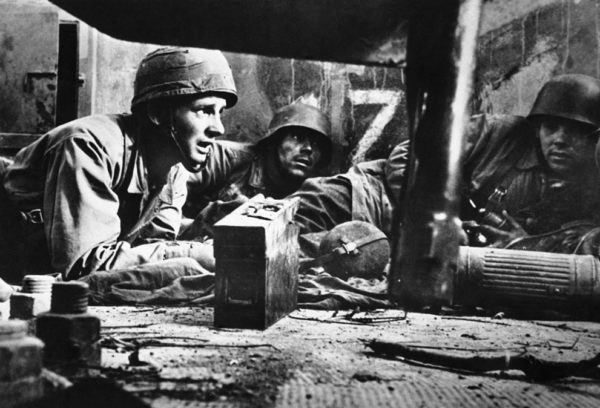 11th November just before dawn, Paulus unleashed his final assault on the last remaining pockets of resistance. His newly organised battle groups from the 71st, 79th, 100th, 295th, 305th and the 389th infantry divisions had all been reinforced with four fresh pioneer battalions. Most of these divisions were severely depleted by the recent fighting within the city, but it was still a significant sized force. The Luftwaffe at this point did little to help the attack – again failing to destroy the 62nd Army’s positions.
11th November just before dawn, Paulus unleashed his final assault on the last remaining pockets of resistance. His newly organised battle groups from the 71st, 79th, 100th, 295th, 305th and the 389th infantry divisions had all been reinforced with four fresh pioneer battalions. Most of these divisions were severely depleted by the recent fighting within the city, but it was still a significant sized force. The Luftwaffe at this point did little to help the attack – again failing to destroy the 62nd Army’s positions.
The 62nd Army remained dug in in their trenches, cellars and bunkers. The Siberians led by Batyuk fought a desperate battle to retain their foothold in the Mamaev Kurgan; the main assault however was half a mile further to the North of this point. The assault was aimed towards the Lazur Chemical Factory – an area known as the ‘tennis racket’ due to a rail track that ran around the area in the same shape. The 305th Infantry division and most of the pioneers managed to capture certain key buildings within the complex – however these positions were all retaken in the bitter fighting, and the following day, the attack was halted.
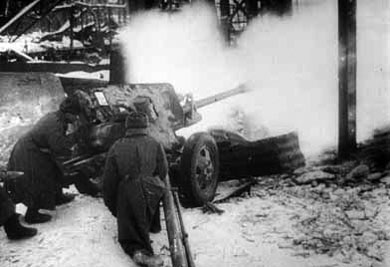
On 12th November at 05:00 a 90 minute artillery barrage on the Dzerzhinsky Tractor Factory began – followed by a strong German assault – creating a wedge between two of the Russian rifle regiments. At 09:50 more Germans were sent into the wedge – some of them advancing towards petrol tanks on the banks of the Volga. One Soviet Rifle Regiment held off the German advance with their backs to the river; the Regiment’s First Battalion was down to fifteen men. Other assault groups flanked the German assaulting force – and in this fighting three German tanks were set alight. These fifteen men managed to hold a line just yards forward of the River Volga.
Only one man survived from the marine infantry guarding the command post – and, with his right hand smashed and unable to fire his weapon, he went into the command bunker and filled his hat with grenades, saying “I can still throw these with my left hand”.
Another platoon fought to the last four surviving members. Having run out of ammunition, they sent a message to the artillery positioned on the Eastern bank of the Volga – “Begin shelling our position. In front of us is a large group of fascists. Farewell comrades, we did not retreat.”
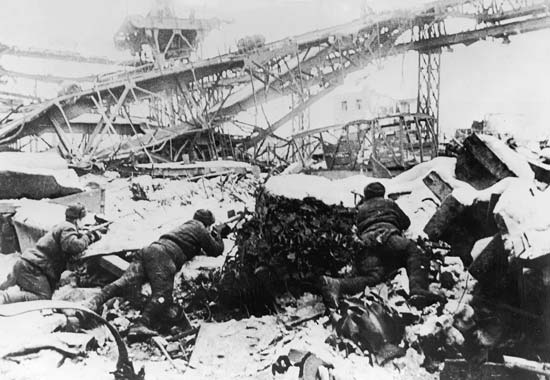
Chuikov and his men remained dug in on the east bank of the Volga and in the sewers. When reinforcements arrived on the west bank of the river they would see the smoke from the city and the wounded who had been evacuated to the western bank awaiting transport to the field hospitals. Reinforcements would be loaded on to boats and ferried across the river, preferably under cover of night but always under constant threat of enemy fire either from air attacks or artillery fire or small arms as they got closer to the east shore. Many boats were sunk en route. Their occupants would jump overboard and try swimming ashore, but many drowned having been dragged under the surface by the weight of their personal equipment and the current of the river.
Operation Uranus
Operation Uranus was the Soviet counter offensive and it caught the Germans completely off guard. They did not expect this whatsoever, especially in the winter months. They believed the Soviet forces lacked the strength to muster any form of counter attack.
What the Wehrmacht didn’t take into consideration was the amount of troops being brought in from Eastern Russia – fresh, rested troops were now arriving fully supplied, and with better equipment. The plan was simple – first, troops approach from the North West and attack the German flanks consisting mainly of Romanian troops. Second, a simultaneous attack from the south, again at the weaker Romanian troops. Both the Northern and Southern flanks of the Wehrmacht army were very well defended, given the lack of training the soldiers of the Romanian forces had received in building defensive positions.
By the 3rd day of Operation Uranus the German forces were surrounded in Stalingrad. Then on the 23rd November the two Russian offensives met in the town of Kalach. Paulus and between 250,000 and 300,000 of his 6th army were now encircled. It was suggested that the 6th army should fight their way out and make another defensive line to the west of the River Don. Hitler gave a flat “No”.
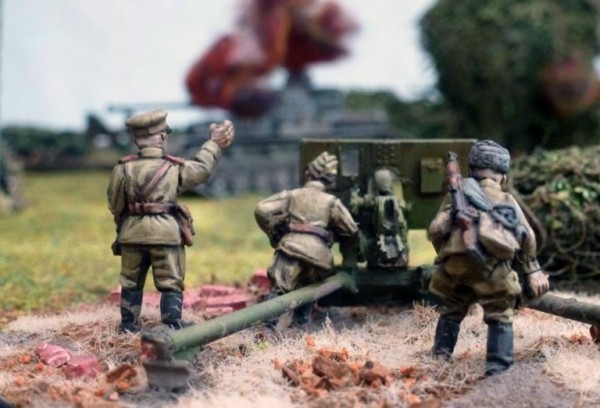
Things were not going well for the Wehrmacht. On the 12th December General Manstien launched an offensive to act as a break-through to get to Paulus and his 6th army – Operation Winter Storm. However – another Soviet counter offensive threatened to encircle Manstein’s own force, and so on the 24th December his attack was called to a halt. The breakthrough had failed.
The Luftwaffe was now expected to resupply the 6th army as promised by Goering. The problems here were that the German forces required 800 tons of supplies a day; the air force could deliver 117.5 tons a day. This, along with bad weather and the Russians’ own air force, meant that things were getting worse for the troops on the ground. German soldiers began to suffer the effects of starvation – on the 8th January 1943 terms for surrender were submitted to the Germans, but Germany refused.
A radio message was received on the 30th January telling Paulus he had been promoted to Field Marshal – Paulus knew what this meant. No German Field Marshal had ever surrendered. This was Hitler’s way to tell him “hold till the last man” – and if necessary, he must commit suicide rather than face capture.
On the 2nd February however Paulus and his 6th army surrendered. He was heard to say to some of his officers, “I am a practicing Christian and I do not agree with suicide.” With this surrender 250,000 – 300,000 German soldiers became POWs of the Soviet forces. A fate from which many would not return.
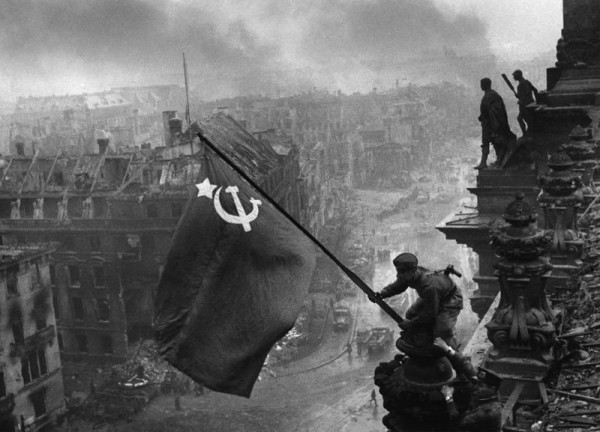
Turning Point
The battle of Stalingrad is considered by many historians to be the ultimate turning point and most decisive battle of World War II. These few months in the eastern front are also thought to be one of the bloodiest battles in the history of warfare. It is estimated that over 2 million died in the 5 months of this one battle. There was a complete disregard for both military and civilian casualties in the battle for Stalingrad. But in the aftermath of this one battle, the Germans would begin a long string of defeats as they retreated with the might of the Red Army hot on their heels.
Article written by Dave Warrilow
For more information about the Battle of Stalingrad, and for specific rules for urban fighting – head over to the webstore for a copy of our ‘Ostfront’ Theatre Book for Bolt Action – which is packed with new scenarios, Theatre Selectors, new units, and characters for the Eastern Front conflict!

